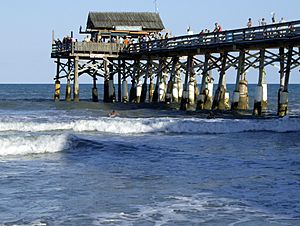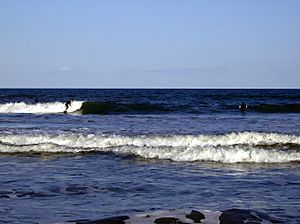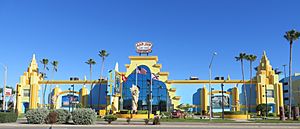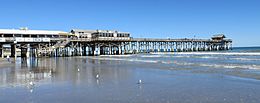Cocoa Beach, Florida facts for kids
Quick facts for kids
Cocoa Beach, Florida
|
||
|---|---|---|
| City of Cocoa Beach | ||
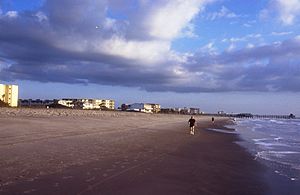
Cocoa Beach
|
||
|
||
| Nickname(s):
The beach city
|
||
| Motto(s):
"Uptown. Downtown. The Beaches."
"Open for Business!" |
||
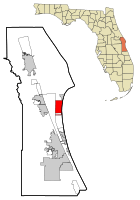
Location in Brevard County and the state of Florida
|
||
| Country | ||
| State | ||
| County | ||
| Settled (Oceanus Settlement) | 1888 | |
| Incorporated (Town of Cocoa Beach) | June 5, 1925 | |
| Incorporated (City of Cocoa Beach) | June 29, 1957 | |
| Government | ||
| • Type | Commission-Manager | |
| Area | ||
| • Total | 15.19 sq mi (39.34 km2) | |
| • Land | 4.66 sq mi (12.06 km2) | |
| • Water | 10.53 sq mi (27.28 km2) | |
| Elevation | 10 ft (3 m) | |
| Population
(2020)
|
||
| • Total | 11,354 | |
| • Density | 2,437.53/sq mi (941.07/km2) | |
| Time zone | UTC−5 (Eastern (EST)) | |
| • Summer (DST) | UTC−4 (EDT) | |
| ZIP code |
32931
|
|
| Area code(s) | 321 | |
| FIPS code | 12-33450 | |
| GNIS feature ID | 0284502 | |
Cocoa Beach is a city in Brevard County, Florida, United States. It's known for its beautiful beaches and connection to space exploration. In 2020, about 11,354 people lived there. Cocoa Beach is part of the larger Palm Bay–Melbourne–Titusville, Florida area.
Contents
History of Cocoa Beach
The first people to settle in this area who were not Native Americans were a family of freed slaves after the American Civil War. Later, in 1888, some men from Cocoa bought the land. It wasn't until 1923 that Gus Edwards, a lawyer from Cocoa, bought the land and started to develop it.
Before it became a town, the area was called Oceanus. The Town of Cocoa Beach was officially created on June 5, 1925. Gus C. Edwards became the first mayor. Soon after, plans for a pier were made.
Early Developments and Growth
In 1935, a dirt road, now called State Road A1A, was opened. By 1939, only 49 people lived in the town. In the 1940s, the town started to get ready for people working at the new Naval Air Station Banana River. They even started thinking about regular garbage collection!
During World War II, two ships were sunk by a German submarine off the coast of Cocoa Beach. Because of this, the government ordered a blackout, meaning no lights could be seen from the coast at night, to protect ships.
After the war, Cocoa Beach faced money problems but kept growing. In 1947, they hired their first police officer and built a water system. A volunteer fire department started in 1950. The town also worked on paving roads and adding its first stoplight.
In 1954, a library opened, and in 1955, the town prepared for many new people moving in because of the missile launches happening at what is now Cape Canaveral Air Force Station.
On June 29, 1957, Cocoa Beach officially became a city.
The Space Age and Beyond
Cocoa Beach grew a lot in the 1960s. The number of people living there increased by 1000% from 1950 to 1960! This was mostly because of the U.S. space program. NASA's John F. Kennedy Space Center is about 15 miles (24 km) north of the city. Many people moved to Cocoa Beach for jobs related to space.
After astronauts went to space, the town would hold parades to celebrate them.
When NASA's Apollo program ended, and before the Space Shuttle program fully started, many people lost their jobs. The city's economy struggled, and some people even left their homes.
Cocoa Beach was the setting for the 1960s TV show I Dream of Jeannie, even though it wasn't filmed there. Cocoa Beach High School was also used in the 2002 movie Race to Space.
In 2002, people in Cocoa Beach voted to limit building heights to 45 feet (14 m). However, some older buildings and special permits mean there are still taller buildings.
Geography and Climate
Cocoa Beach covers about 15 square miles (39 km2). About 4.9 square miles (13 km2) is land, and 10.1 square miles (26 km2) is water. To the north is Cape Canaveral, to the south is Crescent Beach, and to the east is the Atlantic Ocean. The city has about 5.6 miles (9.0 km) of oceanfront. To the west is the Banana River.
A long time ago, a powerful hurricane pushed the ocean through the land, creating the Thousand Islands in the Banana River. Many homes in Cocoa Beach are built on land made from mud and sand dredged from the Banana River.
Surrounding Areas
Weather in Cocoa Beach
Cocoa Beach has a humid subtropical climate. This means it has hot and humid summers with lots of rain and thunderstorms. Winters are warm, dry, and sunny. The average high temperature in July (the warmest month) is 91°F (33°C), and in January (the coolest month) it's 72°F (22°C).
| Climate data for Cocoa Beach | |||||||||||||
|---|---|---|---|---|---|---|---|---|---|---|---|---|---|
| Month | Jan | Feb | Mar | Apr | May | Jun | Jul | Aug | Sep | Oct | Nov | Dec | Year |
| Record high °F (°C) | 89 (32) |
92 (33) |
93 (34) |
97 (36) |
99 (37) |
101 (38) |
102 (39) |
101 (38) |
98 (37) |
96 (36) |
91 (33) |
90 (32) |
102 (39) |
| Mean daily maximum °F (°C) | 71 (22) |
74 (23) |
77 (25) |
81 (27) |
86 (30) |
89 (32) |
91 (33) |
91 (33) |
88 (31) |
84 (29) |
79 (26) |
73 (23) |
82 (28) |
| Daily mean °F (°C) | 60 (16) |
63 (17) |
66 (19) |
71 (22) |
77 (25) |
81 (27) |
82 (28) |
82 (28) |
81 (27) |
76 (24) |
70 (21) |
63 (17) |
73 (23) |
| Mean daily minimum °F (°C) | 49 (9) |
52 (11) |
55 (13) |
60 (16) |
67 (19) |
72 (22) |
73 (23) |
73 (23) |
73 (23) |
68 (20) |
60 (16) |
53 (12) |
63 (17) |
| Record low °F (°C) | 17 (−8) |
27 (−3) |
25 (−4) |
35 (2) |
47 (8) |
55 (13) |
60 (16) |
60 (16) |
57 (14) |
41 (5) |
30 (−1) |
21 (−6) |
17 (−8) |
| Average precipitation inches (mm) | 2.27 (58) |
2.63 (67) |
3.28 (83) |
2.13 (54) |
3.29 (84) |
6.71 (170) |
5.96 (151) |
7.68 (195) |
7.64 (194) |
5.06 (129) |
2.88 (73) |
2.57 (65) |
52.1 (1,323) |
| Source: Weather.com | |||||||||||||
People of Cocoa Beach
| Historical population | |||
|---|---|---|---|
| Census | Pop. | %± | |
| 1930 | 31 | — | |
| 1940 | 49 | 58.1% | |
| 1950 | 246 | 402.0% | |
| 1960 | 3,475 | 1,312.6% | |
| 1970 | 9,952 | 186.4% | |
| 1980 | 10,926 | 9.8% | |
| 1990 | 12,123 | 11.0% | |
| 2000 | 12,482 | 3.0% | |
| 2010 | 11,231 | −10.0% | |
| 2020 | 11,354 | 1.1% | |
| U.S. Decennial Census | |||
In 2020, there were 11,354 people living in Cocoa Beach. The average age was about 58 years old. Many people are older than 65, but about 10.8% of the population is under 18. The city has a nearly even split between females (49.6%) and males (50.4%).
The average household income in 2020 was $73,901.
Economy and Tourism
Cocoa Beach is a very popular place for tourists, especially for surfing! The famous Ron Jon's gets about 2 million visitors every year. Cocoa Beach is also home to the East Coast Surfing Hall of Fame.
The Cocoa Beach Pier, built in 1962, is a popular spot. Many events happen here, like the annual Easter Surfing Festival, which started in 1964 and attracts around 100,000 people. The "Surfing Santas" festival around Christmas also draws about 10,000 visitors.
The largest charity surfing festival, the National Kidney Foundation Pro-Am Surfing Festival, has been held in Cocoa Beach every Labor Day Weekend since 1985.
Tourism brings a lot of money to the city. In 2015, businesses in Cocoa Beach collected $5.6 million in tourist taxes.
Education in Cocoa Beach
The city has three public schools:
- Freedom 7 Elementary
- Theodore Roosevelt Elementary
- Cocoa Beach High School
Both Freedom 7 Elementary and Cocoa Beach Jr./Sr High School are special International Baccalaureate (IB) schools. This means they offer unique learning programs. Most adults (96.1%) in Cocoa Beach have graduated from high school, and many (42.3%) have a college degree or higher.
Landmarks and Places to See
- Cocoa Beach Pier
- Alan Shepard Beachfront Park
- Thousand Islands Conservation Area
- Cocoa Beach Aquatic Center and Pool Complex
- I Dream of Jeannie Lane
Former Landmark
- Cocoa Beach Glass Bank
City Infrastructure
Roads and Travel
The main roads in Cocoa Beach are:
 SR A1A – This is the main road that runs through the city from north to south, often called Atlantic Avenue or Orlando Avenue.
SR A1A – This is the main road that runs through the city from north to south, often called Atlantic Avenue or Orlando Avenue. SR 520 – This road connects Cocoa Beach to the mainland.
SR 520 – This road connects Cocoa Beach to the mainland.
About 2.4 million day-trippers visit Cocoa Beach every year. This is great for businesses, but it can make parking a challenge!
Public Transportation
Public transportation in Cocoa Beach and nearby areas is provided by Space Coast Area Transit.
Canals
Cocoa Beach has 37 canals, which are like small waterways, totaling about 9 miles (14 km). There are also 17 miles (27 km) of larger channels. The city helps maintain these waterways.
Famous People from Cocoa Beach
Many interesting people have connections to Cocoa Beach, including:
- Kim Adler, a professional bowler
- Allison Anders, a filmmaker
- Emanne Beasha, a singer
- Willam Belli, a drag queen, actor, and YouTuber
- Dana Brown, a surfing legend
- Cullen Douglas, an actor and screenwriter
- James Folston, a professional football player
- Ashlyn Harris, a professional soccer player
- Jay F. Honeycutt, a former director of the Kennedy Space Center
- Zora Neale Hurston, a famous author
- Rick Martel, a former professional wrestler
- Bubba McDowell, a professional football player
- Al Neuharth, founder of USA Today
- Kelly Slater, an 11-time World Champion professional surfer
- George Steele, a professional wrestler
- Carrot Top, a comedian and actor
- Lori Wilson, a Florida state legislator
- Melissa Witek, Miss Florida USA 2005
- Nancy Yasecko, a filmmaker
See also
 In Spanish: Cocoa Beach para niños
In Spanish: Cocoa Beach para niños



